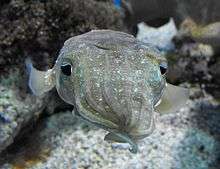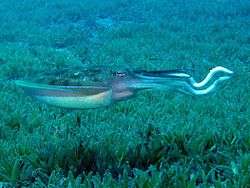Pharaoh cuttlefish
The pharaoh cuttlefish (Sepia pharaonis) is a large cuttlefish species, growing to 42 cm in mantle length and 5 kg in weight.[2] It is also known as seiche pharaon.[3]
| Pharaoh cuttlefish | |
|---|---|
 | |
| Scientific classification | |
| Kingdom: | Animalia |
| Phylum: | Mollusca |
| Class: | Cephalopoda |
| Order: | Sepiida |
| Family: | Sepiidae |
| Genus: | Sepia |
| Subgenus: | Sepia |
| Species: | S. pharaonis |
| Binomial name | |
| Sepia pharaonis Ehrenberg, 1831 | |
 | |
| Range of the S. pharaonis cuttlefish | |
| Synonyms | |
Sepia pharaonis is likely a complex of at least three species, Sepia pharaonis I, commonly located in the Red Sea and Persian Gulf, S. pharaonis II, located from Japan to the Gulf of Thailand and northern Australia; and S. pharaonis III, located from the Indian Ocean to the Andaman Sea.[1]
The type specimen was collected in the Gulf of Suez and is deposited at the Museum für Naturkunde in Berlin.[4]

Range and habitat
The pharaoh cuttlefish is native to at least the western Indian Ocean, including the Red Sea and Persian Gulf.[5] Of all the cuttlefish species in the Persian Gulf, it is the most commonly caught. When hunting at night, it swims up to shallower parts of the sea to feast on a variety of smaller fish, crabs, and occasionally other cuttlefish.[6] It is thought to have reached the Mediterranean Sea as a Lessepsian migrant via the Suez Canal after many of its cuttlebones were washed up on beaches in Israel in the early 2000s.[7]
They have been observed to exhibit migratory behavior off of the south-west coast of India.[8] They are more commonly found furthest north during August, and further south in May.[8] They show an even distribution in October and February. Additionally, there are more juveniles present in May, and more adults present in August.[8]
The Pharaoh cuttlefish prefer a medium to high amount of sunlight for den location during the day. Additionally, they prefer mud substrata during the day, and either sand or mud substrata during the night.[9]
Hunting
Most cephalopods use their two elongated tentacles for prey hunting, and particularly cuttlefish are known to use a three step process of attention, positioning, and seizure. Adult pharaoh cuttlefish and most juveniles begin their attention stance with throwing their arms and tentacles into a triangle shape turning to the prey, followed by a positioning stage where the tentacles are moved slowly from the center of the triangle as they move towards their prey. They finish this with their seizure phase where they move forward until lunging their tentacles rapidly to grasp their prey before retracting the prey back towards them. Due to their small squat body size and lack of speedy propulsion, Sepia pharaonis have adapted to use this ambush style of tentacle lunging.[10]
Reproduction
Pharaoh cuttlefish reproduce similarly to most other cuttlefish. Large males compete in combat until a victor is decided, although it is often decided without any initiation of physical combat. The males circle each other performing threatening displays of color and tentacles until one male swims off in defeat. The victorious male then mates with females by grabbing them with their tentacles, turning the female so that the two animals are face-to-face, then using a specialized tentacle to insert sperm sacs into an opening near the female's mouth. The male then guards the female until she lays the fertilized eggs a few hours later.[11] Females undergo a series of phases when laying their eggs, beginning with a temporary posture where their arms are held in a fist-like position. They follow this with extending their arms forward and venting onto the spawning ground and eggs via their funnels, before extending their arms to deposit the laid eggs onto the proper substrata.[12]
Coloring and Mimicry
Pharaoh cuttlefish often show a solid color when resting on a solid color background, alternating from a pale white to all dark brown. Additionally, they can show a mottled white and brown color, with a center circle of brown. The mechanism for color in the Pharaoh cuttlefish is about the same as it is in other cuttlefish. This color-changing function is produced by groups of red, yellow, brown, and black[13] pigmented chromatophores above a layer of reflective blue and green tinted iridophores and leucophores, with up to 200 of these specialized pigment cells per square millimeter.[14] These sacs of color are controlled by rings of muscle around the sac. The cuttlefish expands and contracts these muscle rings in order to show different colors.
Similarly to other cuttlefish, pharaoh cuttlefish use these chromatophores for camouflage and other cryptic behaviors. They have many types of body patterns, including uniform, mottled, or disruptive. While they have no preference in using any of them, the use of each pattern depends on the surrounding environment as well as predators and prey within the area, and they may even produce a mixed type of body pattern depending on the substrate around them.[15] Depending on the richness of the environment around them, juvenile cuttlefish have exhibited a clear response to color changing and cryptic behavior early on when in sandy loose ocean floors with surrounding objects. Physical enrichment allows the cuttlefish to better explore and learn its surroundings in order to correctly display the coloring and camouflage needed for survival.[16]
In addition to color mimicry, cuttlefish and other cephalopods have shown instances of imitating other species, whether for scaring off predators or luring in prey. The pharaoh cuttlefish in particular has been witnessed exhibiting an arm flapping behavior where their first pair of arms are raised and wrinkled at the distal end (away from the body), with the second and third arm pairs bent and flapped at the distal ends as well. While mostly observed during hunting and believed to be a sort of lure by mimicry of hermit crabs to get closer to prey, as hermit crabs are bottom feeders, the cause of the unique flapping display will need to be further verified.[17]
Human uses
It is a commonly fished species of cuttlefish in the Philippines, as well as the most economically important cuttlefish in the northern Indian Ocean. It is often eaten by humans in these areas. Typically, cuttlefish is consumed as dried, shredded cuttlefish, a popular snack food. And, in the Qing Dynasty manual of Chinese gastronomy, the Suiyuan shidan, the roe of the cuttlefish is considered a difficult to prepare but sought-after delicacy.[18] This species is also being harvested by fishermen as a commercial species in the Suez Canal, Egypt.[19]
Additionally in the past Cuttlefish ink was an important dye, called sepia. Today, artificial dyes have mostly replaced natural sepia.
The ink of the cuttlefish has also been tested for antibacterial properties, and has been found to display the minimum inhibitory concentrations needed to act as an antibiotic to strains such as E. coli and Staphylococcus epidermidis.[20]
References
- Barratt, I. & Allcock, L. (2012). "Sepia pharaonis". IUCN Red List of Threatened Species. 2012: e.T162504A904257. doi:10.2305/IUCN.UK.2012-1.RLTS.T162504A904257.en. Retrieved 6 February 2020.
- Reid, A., P. Jereb, & C.F.E. Roper 2005. Family Sepiidae. In: P. Jereb & C.F.E. Roper, eds. Cephalopods of the world. An annotated and illustrated catalogue of species known to date. Volume 1. Chambered nautiluses and sepioids (Nautilidae, Sepiidae, Sepiolidae, Sepiadariidae, Idiosepiidae and Spirulidae). FAO Species Catalogue for Fishery Purposes. No. 4, Vol. 1. Rome, FAO. pp. 57–152.
- Hanlon, Roger T. (2018-07-25). Octopus, squid & cuttlefish : the worldwide illustrated guide to cephalopods. Allcock, Louise,, Vecchione, Michael. Brighton. p. 47. ISBN 9781782405702. OCLC 1064625063.
- Current Classification of Recent Cephalopoda.
- Norman, M.D. (2000). Cephalopods: A World Guide. ConchBooks.
- Nair (June 1993). "Stock assessment of the pharaoh cuttlefish Sepia pharaonis" (PDF). Indian Journal of Fisheries. 40: 85–94. Retrieved 9 October 2011.
- Giambattista Bello (2006). "Cuttlebones of three exotic Sepia species (Cephalopoda, Sepiidae) stranded on the Apulian coast (Italy), south-western Adriatic Sea". Basteria. 70 (1–3): 1–12.
- Chembian, A. John; Mathew, Saleena (2011). "Migration and spawning behavior of the pharaoh cuttlefish Sepia pharaonis Ehrenberg, 1831 along the south-west coast of India". Indian Journal of Fisheries. 58 (3): 1–8. Retrieved 2016-03-24.
- Nabhitabhata, Jaruwat; Nilaphat, Pitiporn (2000). "Behaviour of Juvenile Cephalopods: Preference for Texture and Brightness of Substrata". Phuket Marine Biological Center Special Publication. 21 (1): 103–112. Retrieved 2016-03-24.
- Sugimoto, Chikatoshi; Ikeda, Yuzuru (2013-08-01). "Comparison of the Ontogeny of Hunting Behavior in Pharaoh Cuttlefish (Sepia pharaonis) and Oval Squid (Sepioteuthis lessoniana)". The Biological Bulletin. 225 (1): 50–59. doi:10.1086/BBLv225n1p50. ISSN 0006-3185.
- "Cuttlefish Husbandry: Part IV - How do cuttlefish reproduce? - The Cephalopod Page". www.thecephalopodpage.org. Retrieved 2016-04-10.
- Lee, Mong-Fong, Lin, Chun-Yen, Chiao, Chuan-Chin, Lu, Chun-Cheng (2016). ""Reproductive Behavior and Embryonic Development of the Pharaoh Cuttlefish, Sepia pharaonis"" (PDF). Zoological Studies. 55: 1–16.CS1 maint: multiple names: authors list (link)
- Messenger, J. B. (2001-11-01). "Cephalopod chromatophores: neurobiology and natural history". Biological Reviews. 76 (4): 473–528. doi:10.1017/S1464793101005772. ISSN 1469-185X. PMID 11762491.
- "NOVA | Kings of Camouflage | Anatomy of a Cuttlefish (non-Flash) | PBS". www.pbs.org. Retrieved 2016-03-29.
- Allen, Justine J.; Mäthger, Lydia M.; Barbosa, Alexandra; Buresch, Kendra C.; Sogin, Emilia; Schwartz, Jillian; Chubb, Charles; Hanlon, Roger T. (2010-04-07). "Cuttlefish dynamic camouflage: responses to substrate choice and integration of multiple visual cues". Proceedings of the Royal Society B: Biological Sciences. 277 (1684): 1031–1039. doi:10.1098/rspb.2009.1694. ISSN 0962-8452. PMC 2842755. PMID 19955155.
- Yasumuro, Haruhiko; Ikeda, Yuzuru (June 2016). "Environmental Enrichment Accelerates the Ontogeny of Cryptic Behavior in Pharaoh Cuttlefish (Sepia pharaonis)". Zoological Science. 33 (3): 255–265. doi:10.2108/zs150197. ISSN 0289-0003.
- Okamoto, Kohei; Yasumuro, Haruhiko; Mori, Akira; Ikeda, Yuzuru (2017-09-01). "Unique arm-flapping behavior of the pharaoh cuttlefish, Sepia pharaonis: putative mimicry of a hermit crab". Journal of Ethology. 35 (3): 307–311. doi:10.1007/s10164-017-0519-7. ISSN 1439-5444. PMC 5711991. PMID 29225406.
- "Page not found – Translating the Suiyuan Shidan". Archived from the original on 2015-12-21. Retrieved 2016-03-29.
- Mienis, H.K. (2003). "Mariene mollusken uit het oostelijk deel van de Middellandse Zee - 15. Invasie van rugschilden van Sepia pharaonis langs de kust van Israel". Spirula (in Dutch). 335: 127–129. Retrieved 20 February 2018. English abstract
- Nithya, M., Ambikapathy, V., Panneerselvam, A. (2011). "Effect of pharaoh's cuttlefish ink against bacterial pathogens" (PDF). Asian Journal of Plant Science and Research. 1(4): 49–55.CS1 maint: multiple names: authors list (link)
